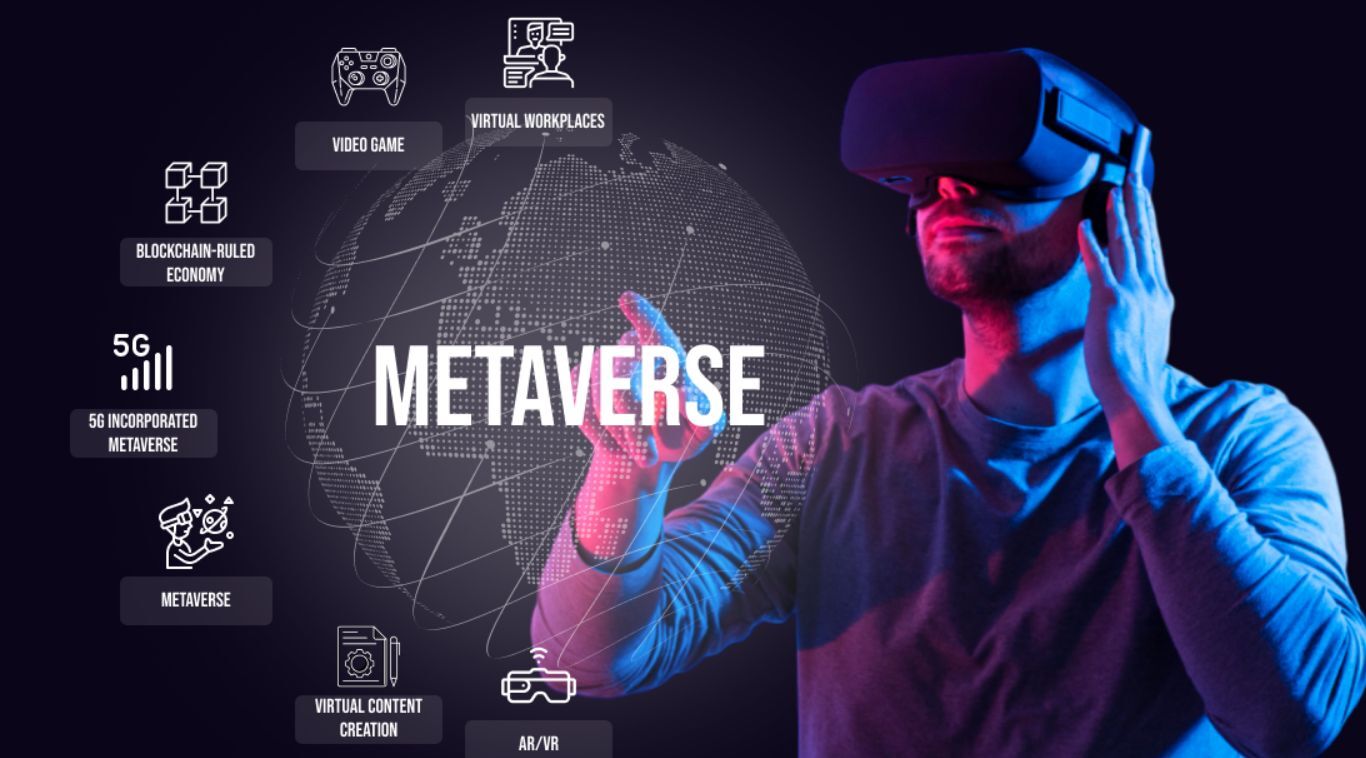
Imagine a world where audiences explore your brand in immersive 3D spaces, interact with virtual products, and engage in real-time experiences — all from the comfort of their homes. Welcome to the metaverse, a transformative digital realm where marketing meets innovation.
This guide reveals the key strategies to unlock the full potential of this new frontier, helping your brand make a lasting impact in the metaverse revolution.
Current Trends in the Metaverse

The metaverse continues to evolve, influenced by technological advancements, shifting corporate strategies, and changing consumer interests. Key trends shaping the current landscape include:
1. Technological Innovations:
- Advanced 3D Capture Techniques: The development of Gaussian splatting has enabled the creation of photorealistic 3D models using standard smartphones. This technology allows users to capture and reconstruct environments with high fidelity, enhancing the realism of virtual spaces.
- Augmented Reality (AR) Integration: Major tech companies are focusing on AR to bridge physical and virtual experiences. Meta's introduction of Orion AR glasses exemplifies efforts to make AR wearables mainstream, aiming to replace traditional devices like smartphones.
2. Corporate Strategy Shifts:
- Focus on AI and AR: Companies that previously emphasized the metaverse are now pivoting towards artificial intelligence and augmented reality. This shift reflects a strategic move to integrate more immediately applicable technologies into consumer products and services.
- Reevaluation of Metaverse Roles: The initial surge in appointing Chief Metaverse Officers has declined as organizations reassess the metaverse's role within their business models, often integrating its functions into broader digital innovation strategies.
3. Consumer Engagement and Retail Integration:
- Blending Physical and Virtual Retail: Retailers are increasingly incorporating metaverse elements into physical stores. Brands like Valentino Beauty and Shiseido have developed immersive, tech-driven pop-ups, such as smart mirrors and 360-degree pods, allowing consumers to experience products in augmented reality, thereby enhancing engagement and personalization.
4. Market Dynamics and Challenges:
- Financial Investments and Returns: Despite significant investments in metaverse development, companies like Meta have faced substantial financial losses in their VR and AR divisions, leading to strategic reassessments and a cautious approach to future expenditures.
- Consumer Adoption Rates: Adoption of metaverse platforms has been slower than anticipated, with some platforms reporting lower daily active users. This has prompted companies to explore more accessible technologies, such as AR, to engage consumers effectively.
Key Benefits of Marketing in the Metaverse
Marketing in the metaverse offers transformative opportunities for brands to innovate and connect with audiences in ways that traditional marketing channels cannot match. Here are the key benefits:
1. Enhanced Consumer Engagement
The metaverse allows brands to create immersive experiences that captivate audiences. Virtual environments, gamified interactions, and live events keep users engaged for longer periods, fostering a deeper connection between the brand and its audience.
2. Personalized Experiences
The metaverse thrives on customization. Brands can use data and AI to tailor experiences for individual users, offering personalized product recommendations, virtual avatars, or environments that resonate with specific preferences. This level of personalization strengthens customer loyalty and satisfaction.
3. New Revenue Streams
The metaverse opens up innovative avenues for monetization. Brands can sell virtual goods, NFTs, and exclusive content, generating revenue in ways not possible in traditional markets. For example, limited-edition virtual fashion or branded game items can drive both sales and brand awareness.
4. Global Reach in a Borderless World
Virtual environments transcend geographical barriers, enabling brands to connect with a global audience. This scalability means businesses can engage diverse demographics and expand their presence into previously untapped markets.
5. Stronger Community Building
The social aspect of the metaverse fosters a sense of community among users. By creating spaces for users to interact with each other and with the brand, companies can build long-lasting relationships and nurture brand advocates.
Core Principles of Metaverse Marketing
Marketing within the metaverse requires a fresh perspective, focusing on immersive, interactive, and community-driven experiences. To effectively engage users in this evolving digital landscape, brands should adhere to the following core principles:
1. Develop Immersive Brand Experiences
Creating engaging and interactive virtual environments is essential. Brands can establish virtual stores, host live events, or design gamified experiences that allow consumers to interact with products and services in novel ways. For instance, Coach launched a large-scale project in metaverse platforms like Roblox and Zepeto, enabling users to participate in styling challenges and purchase digital items modeled after their physical products.
2. Community Building and Social Interaction
At its core, the metaverse is a social platform where communities form and interact. Brands should focus on cultivating these communities by creating spaces that encourage user interaction and participation. This approach not only builds brand loyalty but also provides valuable insights into consumer preferences and behaviors. For example, establishing virtual lounges or forums where users can discuss and share experiences related to the brand can strengthen community ties.
3. Personalization and User-Centric Content
Personalization is key in the metaverse. By utilizing data analytics, brands can tailor experiences to individual users, making interactions more relevant and engaging. This could involve customizing virtual goods, offering personalized virtual spaces, or providing content that aligns with the user's interests and behaviors. Such targeted approaches can significantly enhance user satisfaction and brand affinity.
4. Seamless Integration with Physical and Digital Worlds
The metaverse blurs the lines between physical and digital realities. Brands should strive to create seamless experiences that integrate both realms. This might include virtual try-ons that lead to physical purchases, digital twins of physical products, or virtual events that complement real-world campaigns. Such integration ensures a cohesive brand experience across all touchpoints.
5. Commitment to Innovation and Experimentation
The metaverse is an evolving landscape, and brands must be willing to innovate and experiment. Adopting a test-and-learn mindset allows brands to explore new technologies and platforms, understand what resonates with their audience, and stay ahead of the competition. This proactive approach can lead to the discovery of effective strategies and the development of unique brand experiences.
6. Embrace a Test-and-Learn Mindset
The metaverse is an evolving landscape, and brands should be prepared to experiment with different strategies, learn from outcomes, and adapt accordingly. Adopting a flexible approach allows marketers to stay responsive to technological advancements and shifting consumer behaviors. As noted by McKinsey & Company, now is the right time to adopt a test-and-learn mindset, to be open to experiments in the metaverse, and to move on quickly from failure and capitalize on success.
7. Prioritize Data Privacy and Security
As interactions in the metaverse involve the collection of user data, brands must prioritize data privacy and security. Implementing robust data protection measures and being transparent about data usage can help build consumer trust and comply with regulatory standards. LVMH, for instance, emphasizes technology’s role in luxury retail while prioritizing brand safety, focusing on metrics like engagement and cost reduction.
Building a Metaverse Marketing Strategy
Developing a metaverse marketing strategy involves creating immersive, interactive experiences that resonate with users in virtual environments. To effectively build such a strategy, consider the following steps:
1. Define Clear Objectives
Before diving into the metaverse, establish what you want to achieve. Common objectives include:
- Brand Awareness: Build your presence in virtual spaces.
- Customer Engagement: Foster deeper connections through immersive experiences.
- Sales: Leverage virtual commerce (v-commerce) and NFTs for direct revenue.
- Innovation: Establish yourself as a forward-thinking brand.
2. Know Your Audience
Metaverse users are typically tech-savvy, value immersive experiences, and are highly engaged in gaming, AR, and VR environments. Understand their behaviors and preferences by:
- Conducting surveys and focus groups.
- Analyzing data from metaverse platforms.
- Engaging directly with users in virtual communities.
3. Collaborate with Influencers
Metaverse influencers, known as "virtual influencers" or gamers with large followings, can amplify your reach. Partner with creators who align with your brand to:
- Promote your products or experiences.
- Drive engagement through live streams or in-world events.
4. Prioritize Interoperability
Users expect a seamless experience across different metaverse platforms. When developing virtual assets or experiences:
- Ensure compatibility across platforms.
- Adopt open standards for virtual goods, making them usable in multiple ecosystems.
5. Invest in AR/VR Technologies
A metaverse strategy often requires integrating AR and VR capabilities into your marketing efforts. This could include:
- AR filters and try-on experiences for social media.
- VR experiences for deeper engagement.
6. Measure and Optimize
As with any marketing strategy, analytics is key. Use tools to measure:
- User engagement (e.g., time spent, interactions).
- Conversion rates from virtual experiences to real-world sales.
- Brand sentiment within the metaverse community. Analyze these metrics to refine your strategy and improve ROI.
7. Stay Ethical and Inclusive
The metaverse is still a developing space, and ethical considerations are paramount. Ensure your marketing strategy:
- Respects user privacy and data security.
- Avoids exploitative practices, especially with NFTs or virtual goods.
- Promotes inclusivity and accessibility for all users.
By thoughtfully integrating these elements, brands can craft a metaverse marketing strategy that not only captivates users but also achieves meaningful business outcomes in this emerging digital frontier.
Leveraging Content in the Metaverse
1. Key Strategies for Leveraging Content
A. Immersive Storytelling
Storytelling in the metaverse transcends traditional linear narratives. It allows users to become part of the story, offering agency and interaction.
- Interactive Narratives: Develop multi-branching stories where users’ choices influence the outcome.
- Branded Experiences: Use the metaverse to build engaging stories around your brand, turning customers into participants.
- Gamification: Introduce challenges, rewards, or puzzles to keep users engaged.
B. Virtual Events and Experiences

Virtual events are a cornerstone of metaverse content. Brands and creators can host concerts, product launches, or workshops in fully customizable digital spaces.
- Customization: Design branded virtual environments that reflect your identity.
- Interactivity: Enable real-time communication, Q&A sessions, or collaborative activities.
- Global Reach: Tap into worldwide audiences without geographical constraints.
C. User-Generated Content (UGC)
UGC is pivotal in fostering community engagement. By empowering users to create, share, and monetize their own content, brands can deepen loyalty.
- Toolkits: Provide users with the tools to create and customize content, such as avatars or virtual assets.
- Incentives: Reward creators with digital tokens or NFTs for their contributions.
- Collaboration: Partner with influencers and creators to co-develop content.
D. NFT Integration
NFTs enable ownership of digital assets, adding value and exclusivity to content.
- Exclusive Content: Offer limited-edition NFTs tied to experiences, merchandise, or media.
- Interoperability: Allow NFTs to be used across different platforms within the metaverse.
- Membership Models: Use NFTs as tickets or passes for exclusive events or communities.
E. Cross-Platform Presence
The metaverse spans multiple platforms like Decentraland, Roblox, and The Sandbox. Brands need a cohesive presence across these spaces.
- Consistency: Maintain consistent branding while tailoring experiences to each platform’s audience.
- Interconnectivity: Facilitate seamless movement of assets and experiences across platforms.
2. Challenges to Overcome
While the opportunities in the metaverse are vast, challenges remain:
- Technical Barriers: High development costs and technical expertise are required for creating immersive content.
- Adoption Rates: While growing, not all audiences are ready to embrace the metaverse.
- Platform Fragmentation: Navigating the various metaverse platforms can be complex.
- Data Privacy: Balancing personalization with data security is critical.
Overcoming these challenges requires strategic investment in technology, partnerships, and community-building.
3. Metrics for Success
Tracking the effectiveness of metaverse content strategies involves new KPIs beyond traditional metrics:
- Engagement Rates: Time spent interacting with content or events.
- Community Growth: Increase in active users or followers within a metaverse community.
- Monetization Metrics: Revenue from digital assets, events, or NFTs.
- User Feedback: Sentiment analysis and reviews from the community.
4. Future Trends
The evolution of the metaverse will open up new frontiers for content:
- AI-Powered Content Creation: Automated tools for generating immersive environments and narratives.
- Interoperable Digital Economies: Unified systems for using assets across multiple metaverse platforms.
- Hyper-Personalization: Tailoring experiences based on user behavior and preferences.
- Integration with Real-World Events: Bridging physical and virtual experiences for hybrid engagement.
Monetization Opportunities in the Metaverse
1. Virtual Real Estate
Virtual real estate has emerged as one of the most lucrative sectors in the metaverse. Platforms like Decentraland and The Sandbox allow users to purchase, sell, lease, and develop virtual land.
- Buying and Selling Land: Virtual land is often sold as NFTs, enabling owners to prove their ownership. Land in high-traffic areas or near popular landmarks often appreciates in value.
- Leasing Virtual Spaces: Owners can lease their virtual properties to brands or individuals for events, advertisements, or storefronts.
- Development Services: Companies and creators can monetize by offering design and development services for virtual properties, such as building shops, offices, or entertainment venues.
2. Gaming and Play-to-Earn (P2E) Models
Gaming is a cornerstone of the metaverse, with monetization deeply embedded in its ecosystem.
- Play-to-Earn Games: Players can earn cryptocurrency or valuable in-game items by completing tasks, winning battles, or leveling up characters.
- Subscription Models: Game developers can offer premium memberships, granting users exclusive access to content, items, or features.
- Game Development: Independent developers and studios can build games for metaverse platforms, generating revenue through direct sales or microtransactions.
3. Virtual Events and Experiences
The metaverse provides a platform for immersive virtual events, from concerts to conferences.
- Ticket Sales: Users can buy tickets to attend virtual concerts, theater performances, or sporting events.
- Exclusive Access: VIP passes for exclusive areas or behind-the-scenes experiences provide additional revenue streams.
- Customizable Event Spaces: Platforms can rent customizable spaces for businesses or individuals to host their events.
4. Education and Training
Educational institutions and corporations are beginning to explore metaverse-based learning and training environments.
- Virtual Classrooms: Schools and universities can offer immersive virtual courses, charging tuition fees for online learning in a 3D environment.
- Corporate Training: Companies can use the metaverse for employee onboarding, skills training, or virtual simulations, paying for access to tools and content.
- Certification and Credentials: Organizations can sell virtual certifications for completing metaverse-based learning programs.
5. E-Commerce
The metaverse is reshaping online shopping by offering immersive and interactive experiences.
- Virtual Stores: Brands can set up virtual storefronts where customers can browse and buy digital and physical goods.
- Try-Before-You-Buy: Augmented reality allows users to try on clothes or test products in a virtual environment before making a purchase.
- Dropshipping in the Metaverse: Entrepreneurs can leverage the metaverse to sell goods without holding physical inventory.
6. Freelancing and Creative Services
Creators and freelancers have a wealth of opportunities in the metaverse.
- 3D Design and Animation: Skilled designers can create avatars, environments, and virtual goods for businesses and individuals.
- Content Creation: Writing, music, and video production for metaverse platforms can generate income.
- Consulting Services: Experts can offer guidance on navigating the metaverse or developing strategies for businesses.
7. Social Interactions and Dating Platforms
Socializing in the metaverse extends to dating and relationship-building.
- Virtual Dating Services: Platforms offering virtual matchmaking or date simulations can monetize through subscriptions or one-time fees.
- Social Hubs: Virtual clubs or lounges may charge for access or memberships.
8. Blockchain-Based Finance
Decentralized finance (DeFi) integrates seamlessly with the metaverse, enabling new financial opportunities.
- Staking and Yield Farming: Users can earn rewards by staking metaverse-related tokens.
- Virtual Loans: Platforms may offer loans secured by virtual assets, such as NFTs or land.
- Metaverse Cryptocurrencies: Many platforms have their native tokens, which can be traded or held as investments.
Challenges and Considerations in Metaverse Marketing
While the metaverse offers exciting opportunities, it also presents unique challenges that businesses must navigate to succeed. Here are the key challenges and strategies to overcome them:
1. Accessibility and Inclusivity
Not everyone has access to the technology needed to participate in the metaverse, such as VR headsets or high-speed internet. This digital divide can limit the reach of marketing campaigns.
Recommendations:
- Design experiences that are compatible with multiple devices, including smartphones and desktops.
- Focus on user-friendly interfaces to ensure inclusivity.
2. High Costs of Entry
Developing immersive content, purchasing virtual real estate, and launching campaigns in the metaverse can be expensive, especially for small businesses.
Recommendations:
- Start with smaller-scale projects, like creating NFTs or collaborating with existing metaverse platforms.
- Partner with other brands or creators to share costs and leverage shared audiences.
3. Privacy and Security Concerns
The metaverse's reliance on data for personalization raises concerns about user privacy and data protection. Breaches or misuse of data can erode trust.
Recommendations:
- Adhere to strict data privacy regulations and be transparent about data usage.
- Invest in cybersecurity measures to protect user data and ensure safe transactions.
4. Rapidly Evolving Technology
The metaverse is still in its early stages, with technologies and platforms constantly evolving. This makes it challenging to predict long-term trends and invest strategically.
Recommendations:
- Stay informed about emerging technologies and platforms by investing in ongoing research.
- Build scalable solutions that can adapt to technological advancements.
5. Cultural and Ethical Sensitivity
With a global audience in the metaverse, brands must navigate cultural differences and ensure their campaigns are ethically sound.
Recommendations:
- Conduct cultural research to avoid missteps and ensure campaigns are inclusive.
- Establish ethical guidelines for virtual interactions and advertising.
By addressing these challenges proactively, businesses can position themselves as pioneers in the metaverse, building trust and creating meaningful connections with their audiences.
Summary of Key Points
To succeed in this dynamic digital realm, businesses must embrace innovation, prioritize immersive experiences, and craft strategies that resonate with the unique culture of the metaverse. However, staying adaptable and continuously learning will be critical as the metaverse evolves.
The future of marketing is being written in virtual spaces. Now is the time to step in, experiment, and lead your brand into this exciting new frontier, where creativity and community drive success. The possibilities are endless: are you ready to explore them?




